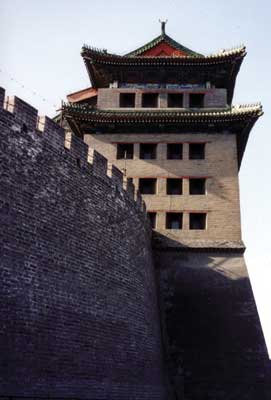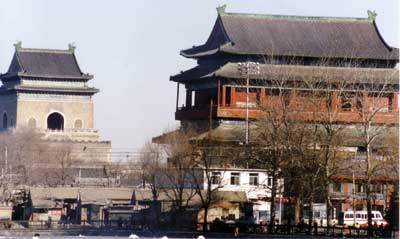| Exploring Beijing's Fascinating Zhonggulou District |
| http://www.sina.com.cn 2004/04/28 08:57 中国周刊 |
In 1402 Ming dynasty emperor Yongle decided to make Beijing his capital. This became a time of much building and even restoration of parts of the city which had suffered hundreds of years of decay and neglect.
Yongle was the emperor who erected the walls of the inner city characterised by its huge gate towers. They are remembered today often by their names alone. Some do still remain as testimony to the strength of the former defensive barriers. Those few remaining they did so because they contained massive amounts of masonry, unlike the city walls, which were much easier to demolish in the 1960's. Beijing actually had nine gates - a number of traditional significance and repeated, for example, in the number of steps laid in series around temples or the gilded studs on the crimson doors of the Forbidden City (Gu Gong) . Each gate had a special function. For example, Deshengmen, the Gate of Virtue and Victory, was used for the imperial army's exit and entrances before and after military campaigns. Some gates were reserved for commercial movement. All were incredible structures where many people gathered daily with their animal-hauled carts waiting to pass through. Each gate was closed at night to the sound of a warning from a great bell. The area around the Bell and Drum Towers (Zhonglou and Gulou) is home to many historical streets and districts influenced by the structure of Old Beijing and the presence of its great gates. The towers are collectively known as Zhonggulou and they date from the days of the Yuan dynasty, with the Drum Tower going back to 1297. After fire it was rebuilt under the reign of Emperor Cheng Zong. Both have survived through periods of war and revolution. They were not always in their present position at the top of Di'anmen Wai Dajie where they originally formed the northern point of the old city. Earlier they stood in the centre of the older capital of Dadu. Beijing's exact centre has moved several times in historic times. During the Ming dynasty, emperor Yongle in 1402 had the towers rebuilt east of their original position. They are precisely 100 metres apart.
The present 33 metre high Bell Tower was built in 1747 after the original was destroyed in a fire. Both it and the neighbouring Drum Tower recently underwent extensive renovation to restore them to their original pristine condition. The latter is 46.7 metres high and is an arched wooden structure with layers of upturned eaves covered with grey tube-shaped tiles while the edges are covered with the green glazed variety. Originally it had 24 large drums, but only one has survived. Those on display today are all replacements. The number represented the 24 divisions of the solar year in the traditional Chinese calendar. Every evening at 7:00 pm the drums were struck thirteen times to indicate that the city's gates were about to close and night had started. Every two hours until 5:00 am the drums were struck. By that time the officials who lived in the neighbouring hutong alleys were supposed to be kneeling in front of the Hall of Supreme Harmony in readiness for the morning imperial audience. Failure to be there on time would often result in severe penalties. For the ordinary people, the day started officially at 7:00 am when a great iron bell in the Bell Tower was rung. Later, to allow most of the city to better know the time a great bronze bell was put into the tower. Today the area between the towers is a paved square popular with the elderly exercising or others with thick furry winter hats soaking in the winter sunshine. Pedicab drivers wait in hope that a few well wrapped up tourists may want their trade. The square used to be congested with many little restaurants. These were cleared a few years ago as part of an environmental improvement programme. Now the south-facing Zhonglou illuminated by the sunshine can be seen in its full splendour. Many traditional courtyard houses, or 'siheyuan', sit around this tree-lined square, some with fascinating carved stone piers at their entrances. Catering for the curious travellers exploring this neighbourhood there are now a few small curio shops and even a cafe advertising itself as 'The Romantic Beer Bar of Tibet - Have an Appointment with Heaven'! The street leading south from Zhonggulou, the previously mentioned Di'anmen Wai Dajie is one of the most important of Beijing's old streets because it forms part of the north-south axis critical to the sense of 'harmony' in the capital. Viewed from the top of Coal Hill (Jingshan Park) it can be seen running due south with prominent buildings being mirror images of each other across the southern section of the street. It also crosses a canal leading from Shichahai, the vital water system for the old city. Turning round and looking south from the hill, the axis line can be 'imagined' going through the Forbidden City, Tiananmen Square, Qianmen and south to the Yongdingmen Gate eight kilometres south of Zhonggulou. The north end, close to Gulou Tower is an unplanned jumble of shops selling groceries, bread and household goods. Several Muslim restaurants also crowd there. This area retains a commercial role not found nearer to Jingshan Park because it was one of the original shopping areas of the Ordinary People's City as opposed to the Imperial City which was devoid of commercial activity. This area is also the starting point of one of the city's most fascinating Old Streets, Yan Dai Xie Jie or the 'Lane of the Long-Stemmed Pipe Makers'. The city's alleys often had names indicating their principal activity or industry. Most are straight, usually going east to west. This one having two principal bends is unusual. Today it shows how history can be incorporated into the city's growing cafe bar scene. Imperial Beijing was a city dependent on water transport. Rice and other supplies were brought from the Yangtze region by barges following the Grand Canal. Waterways connected the canal into the series of man-made lakes Beihai, Shichahai and Houhai north of the Forbidden City. Narrow channels spanned by arched bridges, including the attractive Silver Ingot Bridge (Yindingqiao), connected the lakes. Wooden sailing vessels tied up at these constrictions and busy, colourful trading markets developed. It was a scene of great activity - small carts hauled by mules as well as porters with bamboo shoulder poles brought goods from the docks up to the business areas around Gulou. Eventually, with the development of land transport, barge traffic gradually fell away and inevitably commerce along the lane diminished. All that remained were simple food stalls, a few bicycle repair shops and a handful of junk traders around the entrance to a former Daoist temple. The latter with its carved stone protective gargoyles protruding above a grey tiled roof sits next to buildings of former commercial importance, shown by their pseudo-classical entrances. The street returned to the ordinary people - old men in blue padded jackets hanging their bird cages on walls, women pushing simple bamboo prams and people who will repair almost anything. Monks in grey and brown robes from a nearby temple added some colour to the scene. Today the street is changing so fast that what was there yesterday is unlikely to still be there tomorrow. A couple of years ago, some structures cluttering the lane were removed to reveal the original face of many one or two-storey buildings. Large paving stones replaced the broken cobbled roadway and some environmental work was undertaken. Near the eastern entrance art and calligraphy stores, antique outlets and small clothing boutiques opened. Visitors walking to the lakes were increasingly fascinated with its unique architectural and commercial attractions. Its reputation spread and the commercial possibilities of the area came to be realised. Today it is an extension of the sophisticated lakeside cafe bar scene. Last year bars incorporating a variety of individual style and design started opening. First was the two-storey Lotus Bar which was hardly wider than its entrance. Painted maroon and white, this theme is carried on inside. In its upstairs lounge a large moon window offers great views of activity in the lane. Directly across, the Red Storey provides an opportunity to relax in a veritable botanical garden of tall bamboo plants as gentle music drifts through the air. From its glass balcony doors the view again is not to be missed particularly towards the many trees around Shichahai - a scene that is particularly attractive at sunset. New bars continue to open such as the Lotus Roots entered through red and gold carved wooden doors. Meanwhile several former shops have been transformed into smart establishments including a growth of sophisticated designer fashion boutiques, tea shops and Tibetan crafts and jewellery stores advertising that heavenly land as 'The World's Paradise'. Even the former Daoist temple has recently been transformed into the 'Euang Fu Temple's Forcing House Café8217. In its finely decorated arched entrance tall pot plants now sit on concrete plinths. In the midst of the change, the older life still goes on, seemingly oblivious to the surrounding speed of change. Next to the fashion boutiques, traditional tailors still continue their timeless skills, people repair shoes from the back of bicycle carts and women hang out their washing next to old folk enjoying the warmth of the sun. The lane illustrates the transformation and dilemma happening in Beijing - how to retain something of the old way of life while accepting the demands of modern sophisticated lifestyles. The challenge is modernising some of the old and keeping it for the new generation. It is part of the city's heritage. Certainly, this area around Gulou offers a modern bar scene that is incorporated into an older world. In a sense, it is history and fun together. A successful combination? Time will tell. This whole area has a maze of streets whose stories are too long for this one articles, but their tales, and those of Old Beijing, will continue to be recalled in the coming months. By Bruce Connolly |
| 【英语学习论坛】【评论】【大 中 小】【打印】【关闭】 |

